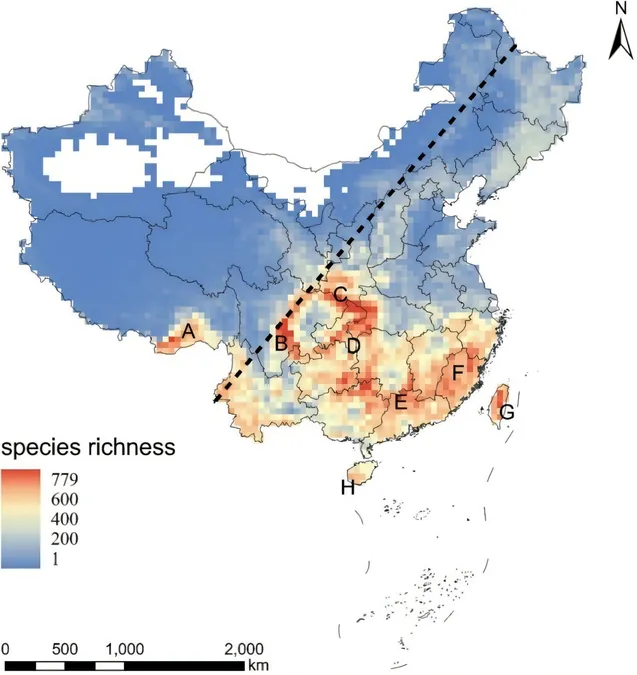
Groundbreaking Study Uncovers Butterfly Diversity Across China: What You Need to Know!
2025-01-02
Author: Mei
Introduction
In an exciting development, Wang Rongjiang's research group from the School of Life Sciences and the Center for Ecological Research at Peking University has unveiled a monumental study detailing the intricate patterns of butterfly diversity in China. Over the span of more than seven decades, the team meticulously gathered a staggering 247,248 observational records encompassing 1,920 distinct species of butterflies, resulting in what is now the most comprehensive butterfly distribution database the country has ever seen.
Study Overview
Published in the esteemed journal Global Ecology and Biogeography, this pioneering research utilized advanced ensemble species distribution models to predict the habitats of various butterfly species, subsequently mapping out their diversity patterns across the vast landscapes of China. This initiative shines a spotlight on a crucial, yet often overlooked, component of biodiversity — the remarkable world of insects, especially butterflies, which are not only a vital part of our ecosystems but also indicators of environmental health.
Biodiversity Importance
Insects represent the richest animal group in terms of species diversity, yet the focus of biodiversity research has largely been skewed towards vertebrates, leaving a significant gap in our understanding of insect distribution. This oversight poses a considerable threat to insect populations globally, which is particularly alarming given that China is recognized as a biodiversity hotspot. Addressing this gap is essential for developing effective conservation strategies aimed at safeguarding these fragile ecosystems.
Findings and Trends
The study's findings reveal a striking trend: butterfly species richness is notably higher in China’s southeastern regions, peaking in its mountainous areas, while the northwest shows alarming declines in diversity. These environmental patterns not only inform our understanding of butterfly ecology but are vital in shaping conservation policies aimed at preserving these enchanting creatures.
Key Species and Environmental Factors
The research also pinpointed that certain butterflies, such as the golden-spotted beaked butterfly — classified as a national first-class protected species — have extensive potential distribution areas measuring an astonishing 717,500 km². The researchers identified actual evapotranspiration (AET) as the key environmental factor affecting butterfly diversity, underscoring the complexity of factors that influence these species.
Urban and Agricultural Importance
Moreover, in a revolutionary approach, the team highlighted the importance of non-traditional environments, such as urban and agricultural lands in southern China, which serve as crucial habitats for various butterfly species. This discovery calls for a reassessment of China’s protective measures for butterflies; for instance, the golden Kaiser-i-Hind butterfly (Teinopalpus aureus) has a relatively wide distribution area, ranking 1,120th among the studied species, yet remains listed as a Class I protected species. Many other Class II protected butterflies also displayed unexpectedly broad ranges, indicating a pressing need to reevaluate the scientific basis for current protection efforts.
Conservation Concerns
What's more, the study found that less than 30% of the identified butterfly conservation priority areas coincide with existing protected zones, raising critical concerns regarding the effectiveness of current conservation strategies. This revelation emphasizes the need to expand the scope of protected areas to include non-traditional habitats, vital for supporting butterfly populations.
Conclusion
As China commits to international biodiversity targets, including those articulated in the Convention on Biological Diversity, the importance of this research cannot be overstated. With ambitious goals set for 2030 to protect at least 30% of terrestrial areas, the involvement of urban and agricultural landscapes in conservation efforts emerges as a pressing priority.
In summary, this monumental study not only broadens our understanding of butterfly diversity in China but also sets the stage for innovative conservation strategies that could significantly impact the preservation of these delicate and important species. As the world watches, China has a unique opportunity to lead in both biodiversity research and conservation efforts. Will our nation seize this moment? Only time will tell!


 Brasil (PT)
Brasil (PT)
 Canada (EN)
Canada (EN)
 Chile (ES)
Chile (ES)
 Česko (CS)
Česko (CS)
 대한민국 (KO)
대한민국 (KO)
 España (ES)
España (ES)
 France (FR)
France (FR)
 Hong Kong (EN)
Hong Kong (EN)
 Italia (IT)
Italia (IT)
 日本 (JA)
日本 (JA)
 Magyarország (HU)
Magyarország (HU)
 Norge (NO)
Norge (NO)
 Polska (PL)
Polska (PL)
 Schweiz (DE)
Schweiz (DE)
 Singapore (EN)
Singapore (EN)
 Sverige (SV)
Sverige (SV)
 Suomi (FI)
Suomi (FI)
 Türkiye (TR)
Türkiye (TR)
 الإمارات العربية المتحدة (AR)
الإمارات العربية المتحدة (AR)